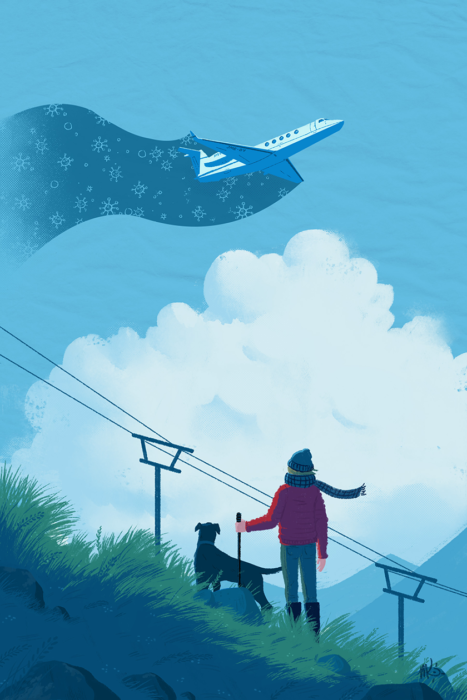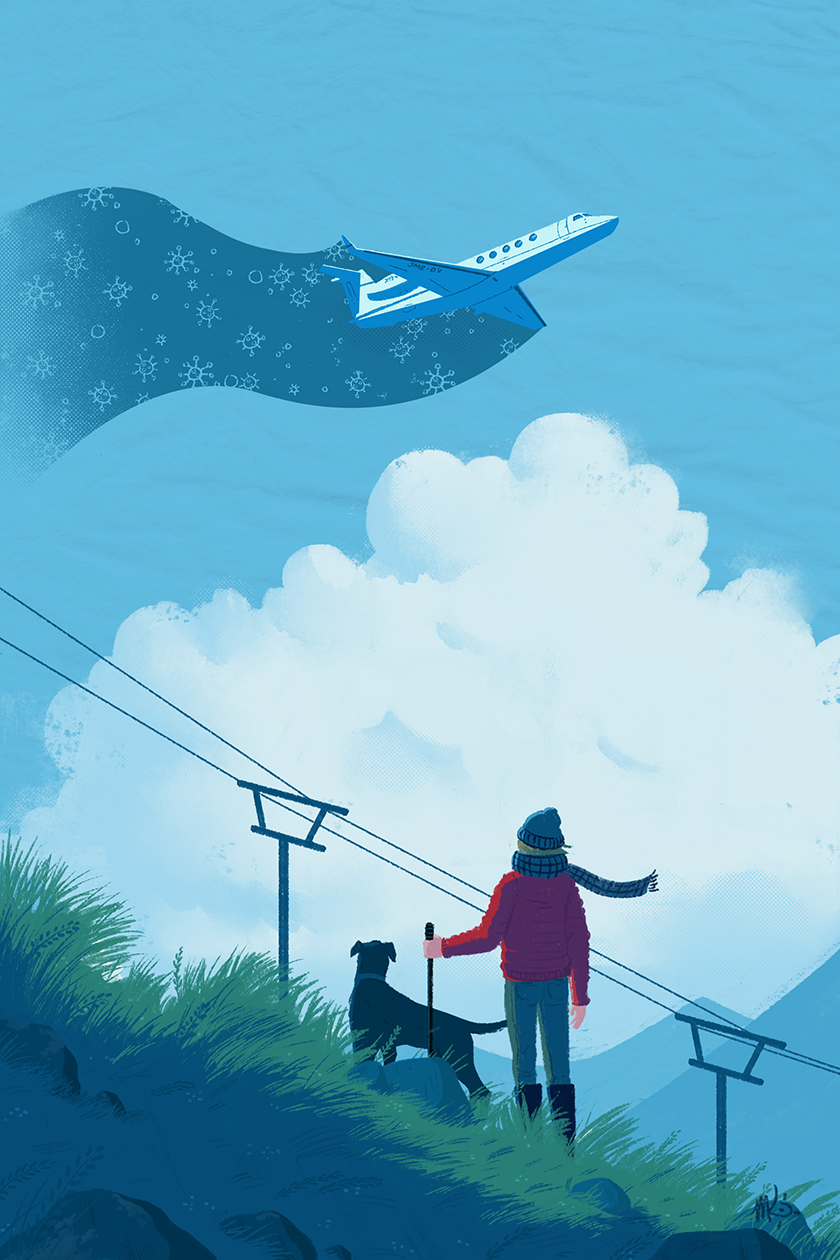
Regular programming on 99.1 La Perrona, a Spanish-language station out of southern Idaho, was interrupted at 10 a.m. on Wednesday morning. Instead of the typical playlist of Mexican artists, host Benjamín Reed interviewed community leaders in Blaine County, a mountainous tract of central Idaho best known for the Sun Valley ski resort and, more recently, one of the nation’s worst outbreaks of COVID-19.
Tammy Davis, a Bellevue town council member and director of the statewide Crisis Hotline, said a bilingual line set up on March 28 had already received 50 calls. “The greatest concerns that I’m hearing … are how they’re going to pay their rent, and just being overall concerned about work and their bills,” she said. Local attorney Salim Star encouraged listeners to get in touch with their landlords early if they couldn’t make rent, and explained the few options available for undocumented workers.
Read all our coverage of the novel coronavirus
Davis’ and Star’s responses were translated to Spanish by Reed and Herbert Romero, a community organizer who helped wrangle the segment on La Perrona. When we spoke this week, Romero told me that such outreach is necessary to provide the area’s roughly 5,000 Latinx residents with reliable information.
“How to navigate resources — that’s the challenge. How do we figure out unemployment? How do we tap into CARES funds, the PPP funds? Businesses don’t understand how to navigate that,” Romero said. “And then you have immigrant families, undocumented, who cannot tap into those resources.”
Resort towns like those in Blaine County have been especially susceptible to the COVID-19 wrecking ball. From an epidemiology standpoint, they are tailor-made for the spread of the virus; the earliest and most severe rural outbreaks were in counties with ski resorts. And in the subsequent economic shutdown, local workers — many of them Latinx — bear the steepest consequences. That has proactive officials and activists teaming up to ensure these communities are able to weather the outbreak.
“A lot of people work season to season, and they have great pride: I’ve lived here for 20 years, and have never filed for unemployment” said Sharel Lund, executive director of One22, a social-services organization in Jackson, Wyoming. “So for there to be this sudden, long-term halt to recreation and nonessential activities is pretty staggering to this community.”
In many ways, ski towns are similar to the urban areas where the virus first showed up: a lot of travel, robust bar and restaurant scenes, and numerous conferences and gatherings. Thus, the coronavirus was quick to emerge in these spots.
Dr. Brent Russell, an emergency physician at St. Luke’s Wood River Medical Center, was one of the earliest confirmed COVID-19 patients in Blaine County. In an Idaho Statesman op-ed, Russell summed up the reason he — and so many others living in tourism-dependent towns — likely contracted the virus. “Loads of people stood in winding security lines to board crowded planes. They came to ski and enjoy this gorgeous place we call home,” he wrote. “Tourists come in groups and socialize, celebrating life. They go to music events, restaurants and bars. So do we.”
But when the hotels, ski slopes, and restaurants empty, the rural reality sets in. The hospital where Russell works has just 25 beds, and the system was quickly overwhelmed; on March 20, it suspended normal operations, and it had to send patients to other St. Luke’s facilities in Twin Falls and Boise (other rural hospital systems lack such a network, and are suffering accordingly).
Similar trends have played out across the West. Utah’s densest COVID cluster is in Park City, home to three ski resorts. Bozeman, gateway to Yellowstone National Park and the Big Sky ski resort, has the most cases in Montana. The areas around Vail and Aspen were among the first in Colorado to register cases, and visitors to those locales transmitted the disease to Australia and Mexico.
“Our mountain communities, like the rest of Colorado, are strong and are independent. We’re going to bounce back,” Governor Jared Polis said in a televised address this week. “This is temporary … there will be a day we’re able once again to embrace tourists from around the world.”
The bounce-back could be black-diamond steep, though. Aspen, Sun Valley, and Park City are among the 16 most unequal places in the country; Jackson tops the chart. Workers, many of them Latinx (most of these areas are about 25 percent Hispanic, per census figures) often live in cramped conditions given the astounding real estate prices in resort towns. Social distancing and a shuttered office are mere inconveniences for a billionaire; but for the working class that props up these local service industries, the economic situation is far more dire.
“People are very concerned about paying their rent on time,” Lund said. “Our housing market is so tight, and there’s usually three people lined up for an apartment in the event you move out.”
That’s why folks like Lund are jumping into high gear. One22 is raising $2 million in relief aid for folks in the valley; as of Thursday, it had doled out around $850,000. In Colorado’s mountain towns, radio host Axel Contreras is making sure Spanish speakers get reliable information on the radio and Facebook.
Back in the Sun Valley area, Romero’s team helped set up the Spanish-language crisis line, and worked with the local National Alliance on Mental Illness affiliate to establish support groups over Zoom. His group has delivered care packages with board games and art projects to more than 50 families. City and county leaders have been reaching out to Romero, he said, to help them best relay health and employment advisories to the local Latinx community.
“It’s not translations — it’s relationships,” Romero said. “People need to know we’re talking, collaborating, and coordinating on some level.”
Hence the segments on La Perrona. On Wednesday, Star, the attorney, was peppered with questions. He advised folks to quickly contact landlords, utilities, and credit card companies if they can’t pay their bills. He also made clear that undocumented immigrants (about 70 percent of Idaho’s foreign-born Latinx people aren’t U.S. citizens) won’t be eligible for unemployment benefits, but they could sign their U.S.-born children up for Medicaid and food stamps.
But he was blunt about the challenges ahead. The Trump administration’s public charge rule has some immigrants scared to access services of any kind, lest it hurt their chances of obtaining a green card. And some employers, he said, might pocket the paycheck protection funds instead of paying their undocumented employees. “When it comes to immigration,” Star said, “I wouldn’t trust what ICE says publicly.”
The radio segments will continue, but Romero isn’t stopping there. This week, he convened a task force dedicated to helping the Latinx community. The goal is to streamline access to resources, run Hispanic-led SBA and unemployment tutorials, and negotiate with landlords and utilities to help folks during these cash-strapped times.
“We’re going to unify our front, we’re going to work together, we’re going to share our information with our community,” he said. “But it needs to be led by us, as Hispanics.”

